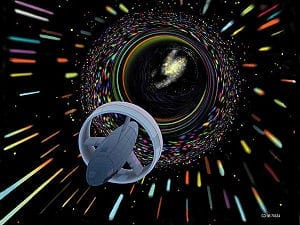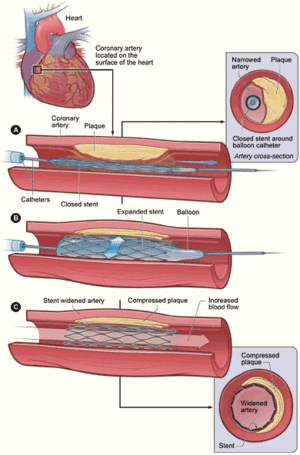
Dr. White believes that advances he and others have made render warp speed less implausible.
Beyond the security gate at the Johnson Space Center’s 1960s-era campus here, inside a two-story glass and concrete building with winding corridors, there is a floating laboratory.
Harold G. White, a physicist and advanced propulsion engineer at NASA, beckoned toward a table full of equipment there on a recent afternoon: a laser, a camera, some small mirrors, a ring made of ceramic capacitors and a few other objects.
He and other NASA engineers have been designing and redesigning these instruments, with the goal of using them to slightly warp the trajectory of a photon, changing the distance it travels in a certain area, and then observing the change with a device called an interferometer. So sensitive is their measuring equipment that it was picking up myriad earthly vibrations, including people walking nearby. So they recently moved into this lab, which floats atop a system of underground pneumatic piers, freeing it from seismic disturbances.
The team is trying to determine whether faster-than-light travel — warp drive — might someday be possible.
Warp drive. Like on “Star Trek.”
“Space has been expanding since the Big Bang 13.7 billion years ago,” said Dr. White, 43, who runs the research project. “And we know that when you look at some of the cosmology models, there were early periods of the universe where there was explosive inflation, where two points would’ve went receding away from each other at very rapid speeds.”
“Nature can do it,” he said. “So the question is, can we do it?”
Einstein famously postulated that, as Dr. White put it, “thou shalt not exceed the speed of light,” essentially setting a galactic speed limit. But in 1994, a Mexican physicist, Miguel Alcubierre, theorized that faster-than-light speeds were possible in a way that did not contradict Einstein, though Dr. Alcubierre did not suggest anyone could actually construct the engine that could accomplish that.
His theory involved harnessing the expansion and contraction of space itself. Under Dr.Alcubierre’s hypothesis, a ship still couldn’t exceed light speed in a local region of space. But a theoretical propulsion system he sketched out manipulated space-time by generating a so-called “warp bubble” that would expand space on one side of a spacecraft and contract it on another.
“In this way, the spaceship will be pushed away from the Earth and pulled towards a distant star by space-time itself,” Dr. Alcubierre wrote. Dr. White has likened it to stepping onto a moving walkway at an airport.
But Dr. Alcubierre’s paper was purely theoretical, and suggested insurmountable hurdles. Among other things, it depended on large amounts of a little understood or observed type of “exotic matter” that violates typical physical laws.
Dr. White believes that advances he and others have made render warp speed less implausible. Among other things, he has redesigned the theoretical warp-traveling spacecraft — and in particular a ring around it that is key to its propulsion system — in a way that he believes will greatly reduce the energy requirements.
He is quick to offer up his own caveats, however, saying his warp research is akin to a university science project that is just trying to prove that a microscopic warp bubble can be detected in a lab. ”We’re not bolting this to a spacecraft,” he said of the warp technology.
The Latest Bing News on:
Faster than the speed of light
- Being in two places at once could make a quantum battery charge fasteron May 8, 2024 at 2:59 pm
The quantum principle of superposition – the idea of particles being in multiple places at once – could help make quantum batteries that charge within minutes ...
- Bigger, faster, thinner, lighter iPad Pro and iPad Air models coming to tackle AIon May 8, 2024 at 1:12 pm
Apple launched its first artificial intelligence product, the M4 Apple silicon chip in a new iPad Pro. Steve Jobs predicted the iPad would replace laptops.
- Deep-space lasers smash data speed records over interplanetary distanceson May 6, 2024 at 12:07 am
NASA’s Psyche spacecraft, farther away than the Sun, has sent data through a laser over a record-breaking distance, and done so even faster than expected.
- The universe may be dominated by particles that break causality and move faster than light, new paper suggestson April 17, 2024 at 12:56 pm
With the nature of the universe's two most elusive components up for debate, physicists have proposed a radical idea: Invisible particles called tachyons, which break causality and move faster than ...
- Miscellany: Faster than Light?on February 26, 2024 at 6:54 pm
That nothing in the universe moves faster than light is a fundamental axiom of modern physics. The velocity of light is accepted as “basic constant,” is given the symbol c for mathematical ...
- Scientists Discover Objects That Move Faster Than The Speed Of Lighton October 20, 2023 at 6:11 am
Nothing in the universe can travel faster than the speed of light. However, a group of physicists recently discovered that quasiparticles – groups of electrons behaving collectively – can ...
- Is A Pigeon Faster Than The Internet?on September 2, 2023 at 9:28 am
Even though he has a brand new high-speed fiber optic internet connection ... that using carrier pigeons to send files can be faster than the internet. [Jeff] sets up an experiment to send ...
- faster than lighton February 7, 2023 at 4:00 pm
While superluminal travel has been regarded as impossible for many years, recent work has suggested ways we might be able to circumvent the light-speed barrier. Unfortunately, all of these ...
- Faster Than the Speed of Light?on March 10, 2021 at 2:11 am
In September 2011, an international group of scientists has made an astonishing claim - they have detected particles that seemed to travel faster than the speed of light. It was a claim that ...
- Best of Last Week–Can space travel faster than light, another planet behind the Sun and should we allow head transplantson March 1, 2015 at 4:00 pm
Thank you for taking time to provide your feedback to the editors. Your feedback is important to us. However, we do not guarantee individual replies due to the high volume of messages.
The Latest Google Headlines on:
Faster than the speed of light
[google_news title=”” keyword=”faster than the speed of light” num_posts=”10″ blurb_length=”0″ show_thumb=”left”]
The Latest Bing News on:
Warp Drive
- Scientists propose warp drive model that doesn’t break laws of physicson May 8, 2024 at 12:48 pm
In science fiction, such as the show Star Trek, warp drives propel spacecraft across galaxies in the blink of an eye. While a lot of things that used to be in the realm of science fiction are now ...
- 'Warp drives' may actually be possible someday, new study suggestson May 7, 2024 at 4:01 am
A new study provides some theoretical underpinning to sci-fi warp drives, suggesting that the superfast propulsion tech may not forever elude humanity.
- New Study Achieves Breakthrough in Warp Drive Designon May 6, 2024 at 4:59 pm
Traditionally, warp drives have been synonymous with faster-than-light travel in popular culture, as seen in an array of films, television shows, and novels. In 1994, physicist Miguel Alcubierre ...
- Applied Physics: New Study Achieves Breakthrough in Warp Drive Designon May 5, 2024 at 3:01 pm
Discovery Brings Science Fiction Closer to Science Fact Today, Applied Physics®, a multidisciplinary group of international scientists, published a milestone study in the prestigious Classical and ...
- This terminal app uses AI to help you understand the command lineon May 1, 2024 at 4:30 am
Every time I've tried this feature, the AI was spot-on, making Warp a handy tool for explaining the bits and pieces of commands, scripts, and even code. So, if you're new to Linux or the MacOS ...
- Scientists Get Serious in the Search for a Working Warp Driveon April 22, 2024 at 8:50 am
While a fully working warp drives has many hurdles to overcome, it’s a technology worth taking seriously. Because if humans have any hope of one day exploring distant stars, it’ll need the help of ...
- Scientists Are Getting Closer to a Real, Working Warp Driveon April 20, 2024 at 5:00 am
This toolkit was created by Applied Physics, an international group of scientists, which hopes to also provide a "reality check" on warp drive concepts that rely on exotic physics. Simply put ...
- Why Warp Drives Are About To Get Betteron April 16, 2024 at 5:00 am
So it’s no surprise that in 1994, the theoretical physicist, Miguel Alcubierre, worked out how a warp drive might work in the real universe. The key feature of a warp drive is that it can propel a ...
- Free software lets you design and test warp drives with real physicson April 16, 2024 at 2:27 am
Warp drives are among the more plausible of science fiction concepts, at least from a mathematical perspective. Now, Applied Physics, a multidisciplinary group of international scientists and ...
- Applied Physics Launches Warp Drive Simulatoron April 9, 2024 at 6:40 am
Coinciding with the release of their research paper, "Analyzing Warp Drive Spacetimes with Warp Factory," published in the Journal of Classical and Quantum Gravity, Warp Factory serves as an open ...
The Latest Google Headlines on:
Warp Drive
[google_news title=”” keyword=”warp drive” num_posts=”10″ blurb_length=”0″ show_thumb=”left”]











